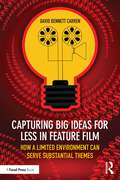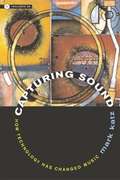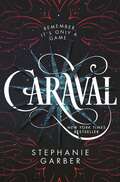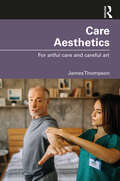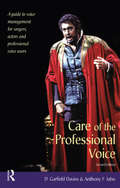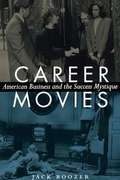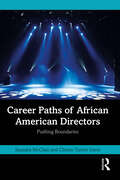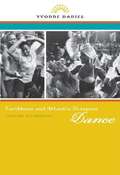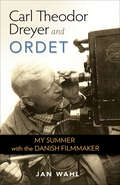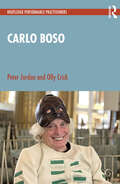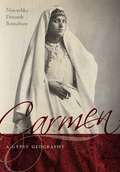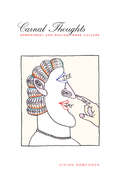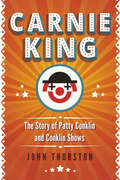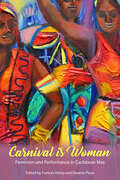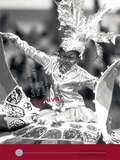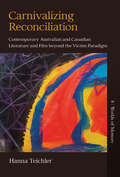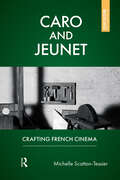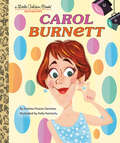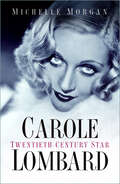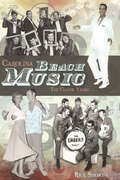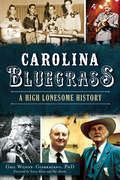- Table View
- List View
Captive Audience: Prison and Captivity in Contemporary Theatre (Studies in Modern Drama #19)
by Thomas Fahy Kimball KingThe first collection on this important topic, Captive Audience examines the social, gendered, ethnic, and cultural problems of incarceration as explored in contemporary theatre. Beginning with an essay by Harold Pinter, the original contributions discuss work including Harold Pinter's screenplays for The Handmaid's Tale and The Trial, Theatrical Prison Projects and Marat/Sade. Kimball King, Thomas Fahy, Rena Fraden, Tiffany Ana Lopez, Fiona Mills, Harold Pinter, Ann C. Hall, Christopher C. Hudgins, Pamela Cooper, Robert F. Gross, Claudia Barnett, Lois Gordon
Capturing Big Ideas for Less in Feature Film: How a Limited Environment Can Serve Substantial Themes
by David Bennett CarrenThis book is an accessible guide, directed towards filmmakers with restricted resources and shortened schedules, who want to ensure their creation of riveting, fresh, and exciting projects. Whether a film is produced under a low or high budget, this text emphasizes that a small world coupled with a big idea can serve strong themes, complex characters, and powerful stories.Award-winning screenwriter David Carren suffuses this book with his own, original Narrative Synonym Process, teaching readers how to redevelop and expand a single idea or element in a story into multiple directions. Each chapter examines case studies of successful films and screenplays that are suitable to the subject. Script to Screen entries evaluate specific scenes in well‑known films in relation to their dramatic intention and budgetary costs. The end of each chapter includes a review of its basic points and a bibliography citing the companies that produced the film, or the publishers of their scripts and/or where to find them, along with an exercise to allow the reader to directly enhance their knowledge and education.Offering a variety of exercises throughout to allow the reader to directly enhance their knowledge and education, this text is an essential resource for film students, screenwriters and filmmakers who want to make strong, successful films from limited resources.
Capturing Sound: How Technology Has Changed Music
by Mark KatzMark Katz explores how recording technology has encouraged new ways of listening to music, led performers to change their practices, and allowed entirely new musical genres to come into existence.
Caraval (Caraval #1)
by Stephanie Garber<P>Whatever you've heard about Caraval, it doesn't compare to the reality. It's more than just a game or a performance. It's the closest you'll ever find to magic in this world . . . <P>Welcome, welcome to Caraval—Stephanie Garber’s sweeping tale of two sisters who escape their ruthless father when they enter the dangerous intrigue of a legendary game. <P>Scarlett has never left the tiny island where she and her beloved sister, Tella, live with their powerful, and cruel, father. Now Scarlett’s father has arranged a marriage for her, and Scarlett thinks her dreams of seeing Caraval, the far-away, once-a-year performance where the audience participates in the show, are over. <P>But this year, Scarlett’s long-dreamt of invitation finally arrives. With the help of a mysterious sailor, Tella whisks Scarlett away to the show. Only, as soon as they arrive, Tella is kidnapped by Caraval’s mastermind organizer, Legend. It turns out that this season’s Caraval revolves around Tella, and whoever finds her first is the winner. <P>Scarlett has been told that everything that happens during Caraval is only an elaborate performance. But she nevertheless becomes enmeshed in a game of love, heartbreak, and magic with the other players in the game. And whether Caraval is real or not, she must find Tella before the five nights of the game are over, a dangerous domino effect of consequences is set off, and her sister disappears forever. <P><b>A New York Times Bestseller</b>
Care Aesthetics: For artful care and careful art
by James ThompsonWhat if the work of a nurse, physio, or homecare worker was designated an art, so that the qualities of the experiences they create became understood as aesthetic qualities? What if the interactions created by artists, directors, dancers, or workshop facilitators were understood as works of care? Care Aesthetics is the first full-length book to explore these questions and examine the work of carer artists and artist carers to make the case for the importance of valuing and supporting aesthetically caring relations across multiple aspects of our lives. Theoretically and practically, the book outlines the implications of care aesthetics for the socially engaged arts field and health and social care, and for acts of aesthetic care in the everyday. Part 1 of the book outlines the approaches to aesthetics and to care theory that are necessary to make and defend the concept of care aesthetics. Part 2 then tests this through practice, examining socially engaged arts and health and social care through its lens. It makes the case for careful art exploring the implications of care aesthetics for participatory or applied arts. Then it argues for artful care and how an aesthetic orientation to care practices might challenge some of the inadequacies of contemporary care. This is a vital, paradigm-shifting book for anyone engaged with socially engaged arts or social and health care practices on an academic or professional level.
Care of the Professional Voice: A Guide to Voice Management for Singers, Actors and Professional Voice Users
by D Garfield Davies Anthony F JahnSinger and actors are a unique group of performers, relying almost entirely on their voice for the professional livelihood. Jet lag, amplification, allergens, stress, pollution, and vocal strain all affect vocal performance. Written for the performer, the teacher, and the vocal coach, Care of the Professional Voice offers clear explanations and medical advice on vocal problems and vocal health. Care of the Professional Voice is written by experts in laryngology in the United States and Great Britain. This second edition includes a singer's guide to self-diagnosis.
Career Movies: American Business and the Success Mystique
by Jack BoozerAnalyzing numerous well-known films from the entire period, he defines the genre as one in which a protagonist strives for career success that often proves to be either elusive despite hard work, or unfulfilling despite material rewards and status. Boozer also explores several distinct subgenres of the career movie—the corporate executive films of the 1950s; the career struggles of (single, married, and/or parenting) women; the entrepreneurial film as it is also embodied in texts about immigrants and racial and ethnic minorities and business-oriented femmes fatales; the explosion of promotionalism and the corporatization of employment; and, finally, the blurring of work and private life in the brave new world of the televirtuality film.
Career Paths of African American Directors: Pushing Boundaries
by Saundra McClain Clinton Turner DavisCareer Paths of African American Directors is a collection of in-depth conversations with African American directors.These conversations provide an insightful overview of the interviewees’ work and artistic vision and explore their personal influences, aesthetic philosophies, directorial styles, and some of the creative successes they achieved while navigating the obstacles, challenges, and biases encountered while establishing their careers in American theatre. The directors are presented with similar core questions as well as pertinent questions related to their own aesthetics, philosophy, and career. Often, these selected directors’ productions are grounded in a non-European aesthetic and philosophy, and their directorial styles are refracted through the prisms of ethnicity, gender, race, and culture, thus bringing a fresh approach to their work and the art of directing.Career Paths of African American Directors will be of interest to actors, early career and established directors, and students of Acting, Directing, and Theatre Studies.
Caribbean and Atlantic Diaspora Dance: Igniting Citizenship
by Yvonne DanielIn Caribbean and Atlantic Diaspora Dance: Igniting Citizenship, Yvonne Daniel provides a sweeping cultural and historical examination of diaspora dance genres. In discussing relationships among African, Caribbean, and other diasporic dances, Daniel investigates social dances brought to the islands by Europeans and Africans, including quadrilles and drum-dances as well as popular dances that followed, such as Carnival parading, Pan-Caribbean danzas,rumba, merengue, mambo, reggae, and zouk. Daniel reviews sacred dance and closely documents combat dances, such as Martinican ladja, Trinidadian kalinda, and Cuban juego de maní. In drawing on scores of performers and consultants from the region as well as on her own professional dance experience and acumen, Daniel adeptly places Caribbean dance in the context of cultural and economic globalization, connecting local practices to transnational and global processes and emphasizing the important role of dance in critical regional tourism.
Carl Theodor Dreyer and Ordet: My Summer with the Danish Filmmaker (Screen Classics)
by Jan WahlThis illustrated memoir shares a rare inside look at the legendary director’s process and vision during the filming of his award-winning masterpiece.Danish director Carl Theodor Dreyer is considered one of the most influential filmmakers in cinematic history. His 1955 film Ordet (The World) won numerous prizes, including the Venice Film Festival’s Golden Lion. In 1954, Dreyer invited young film student Jan Wahl to accompany him during this classic work.This captivating account of Wahl's time with the director is based on Wahl's daily journal and transcriptions of his conversations with Dreyer. Offering a glimpse into the filmmaker's world, Wahl fashions a portrait of Dreyer as a man, mentor, friend, and director. Wahl's detailed account is supplemented by exquisite photos of the filming and by selections from Dreyer's papers, including his notes on film style, his introduction for the actors before the filming of Ordet, and a visionary lecture he delivered at Edinburgh.
Carlo Boso (Routledge Performance Practitioners)
by Peter Jordan Olly CrickCarlo Boso is one of the foremost exponents of Commedia dell’Arte in the contemporary performance world, having trained generations of young actors in its history, techniques and performance. Staying true to – and promoting renewed awareness of – the diverse cultural and linguistic backgrounds of most commedia troupes, his work has also done a great deal to democratize this central pillar of European theatre, placing the actor and the audience squarely at the centre of his craft.This book includes the following:• A biographical account of Boso’s route into commedia, his foundational work and the significance of his practice to contemporary performance.• An extended interview that allows Boso to set out in his own words the key elements of his work and his vision of an articulate, politically and socially engaged actor.• A detailed analysis of his production of La Pazzia di Isabella with TAG Teatro, providing an object lesson in how to make a centuries-old scenario suitable for touring 250 performances across nine countries.• A developmental series of exercises for approaching improvisation material, as well as mask work, composition, music and acrobatics.As a first step towards critical understanding, and as an initial exploration before going on to further, primary research, Routledge Performance Practitioners offer unbeatable value for today’s student.
Carmen, a Gypsy Geography
by Ninotchka Devorah BennahumThe figure of Carmen has emerged as a cipher for the unfettered female artist. Dance historian and performance theorist Ninotchka Bennahum shows us Carmen as embodied historical archive, a figure through which we come to understand the promises and dangers of nomadic, transnational identity, and the immanence of performance as an expanded historical methodology. Bennahum traces the genealogy of the female Gypsy presence in her iconic operatic role from her genesis in the ancient Mediterranean world, her emergence as flamenco artist in the architectural spaces of Islamic Spain, her persistent manifestation in Picasso, and her contemporary relevance on stage. This many-layered geography of the Gypsy dancer provides the book with its unique nonlinear form that opens new pathways to reading performance and writing history. Includes rare archival photographs of Gypsy artists.
Carnal Thoughts
by Vivian SobchackIn these innovative essays, Vivian Sobchack considers the key role our bodies play in making sense of today's image-saturated culture. Emphasizing our corporeal rather than our intellectual engagements with film and other media, Carnal Thoughts shows how our experience always emerges through our senses and how our bodies are not just visible objects but also sense-making, visual subjects. Sobchack draws on both phenomenological philosophy and a broad range of popular sources to explore bodily experience in contemporary, moving-image culture. She examines how, through the conflation of cinema and surgery, we've all "had our eyes done"; why we are "moved" by the movies; and the different ways in which we inhabit photographic, cinematic, and electronic space. Carnal Thoughts provides a lively and engaging challenge to the mind/body split by demonstrating that the process of "making sense" requires an irreducible collaboration between our thoughts and our senses.
Carnie King: The Story of Patty Conklin and Conklin Shows
by John ThurstonThe story of the audacious showman who built the greatest carnival dynasty in North America.Enter the realm of the carnie king, Patty Conklin, the flamboyant founder of what would become the world’s largest carnival company. Patty started on the mean streets of New York selling peanuts before becoming a a small-time operator. Willing to try anything to promote his show, he established himself as a carnie celebrity. Winning the midway contract for the Canadian National Exhibition in 1937, he made it his personal world’s fair. It became the foundation for his son and grandson to expand Conklin Shows until they were playing the biggest fairs and exhibitions throughout North America. Carnie King begins with the birth of Joseph Renker to German immigrant parents, tells of his personal transformation into Patty Conklin, and follows his incredible life through to his death in 1970. It covers his company's history after Jim Conklin took over, expanded it beyond recognition, then handed it on to his own son.Not only a history of Conklin Shows, Carnie King explores how midways work and their commercial and popular presence in North America The story it tells is based on dozens of interviews with carnies and access to the Conklin archives. It includes anecdotes about a range of characters and insights about life on the midway. Carnie King is at once a revealing look at a unique part of twentieth-century culture and a vivid account of three generations of showmen and their dominance of midways across the continent.
Carnival Is Woman: Feminism and Performance in Caribbean Mas (Caribbean Studies Series)
by Frances Henry and Dwaine PlazaContributions by Darrell Gerohn Baksh, Jan de Cosmo, Frances Henry, Jeff Henry, Adanna Kai Jones, Samantha Noel, Dwaine Plaza, Philip W. Scher, and Asha St. Bernard Women are performing an ever-growing role in Caribbean Carnival. Through a feminist perspective, this volume examines the presence of women in contemporary Carnival by demonstrating not only their strength in numbers, but also the ways in which women participate in the event. While decried by traditionalists, the bikinis, beads, and feathers of “pretty mas’” convey both a newly found empowerment as a gendered resistance to oppression from men. Although research on Carnivals is substantial, especially in the Americas, the subject of women in Carnival as a topic of inquiry remains fairly new. These essays address anthropological and historical facets of women and their practices in the Trinidad Carnival, including an analysis of how women’s costuming and performance have changed over time. The modern costumes, which are well within the financial means of most mas’ players, demonstrate the new power of women who can now afford these outfits. In discussing the commodification and erotization of Carnival, the book emphasizes the unveiling of the female body and the hip-rolling sexual movements called winin or it. Through display of their bodies, contemporary women in Carnival express a form of female resistance. Intent on enjoying and expressing themselves, they seem invigorated by their place in the economy, as well as their sexuality, defying the moral controls imposed on them. Through an array of methods in qualitative research, including interviews, participant observation, and ethnography, this volume explains the new power of women in the evolution of Carnival mas’ in Trinidad amid the wider Caribbean diaspora.
Carnival: Culture in Action – The Trinidad Experience (Worlds of Performance)
by Milla Cozart RiggioThis beautifully illustrated volume features work by leading writers and experts on carnival from around the world, and includes two stunning photo essays by acclaimed photographers Pablo Delano and Jeffrey Chock. Editor Milla Cozart Riggio presents a body of work that takes the reader on a fascinating journey exploring the various aspects of carnival - its traditions, its history, its music, its politics - and prefaces each section with an illuminating essay. Traditional carnival theory, based mainly on the work of Mikhail Bakhtin and Victor Turner, has long defined carnival as inversive or subversive. The essays in this groundbreaking anthology collectively reverse that trend, offering a re-definition of 'carnival' that focuses not on the hierarchy it temporarily displaces or negates, but a one that is rooted in the actual festival event. Carnival details its new theory in terms of a carnival that is at once representative and distinctive: The Carnival of Trinidad - the most copied yet least studied major carnival in the world.
Carnivalizing Reconciliation: Contemporary Australian and Canadian Literature and Film beyond the Victim Paradigm (Worlds of Memory #8)
by Hanna TeichlerCriminal justice inquiries may be the most historically dramatic means for coming to terms with traumatic legacies, but it is in the more subtle social and cultural processes of “memory work” that most individuals encounter historical reconciliation in practice. This book analyzes, within the realms of national literature and film, recent Australian and Canadian attempts to reconcile with Indigenous populations in the wake of forced child removal. As Hanna Teichler demonstrates, their systematic emphasis on the subjectivity of the victim is “carnivalesque,” temporarily overturning discursive hierarchies. Such fictions of reconciliation venture beyond simplistic narratives and identities defined by victimization, offering new opportunities for confronting painful histories.
Carnivalizing Reconciliation: Contemporary Australian and Canadian Literature and Film beyond the Victim Paradigm (Worlds of Memory #8)
by Hanna TeichlerTransitional justice and national inquiries may be the most established means for coming to terms with traumatic legacies, but it is in the more subtle social and cultural processes of “memory work” that the pitfalls and promises of reconciliation are laid bare. This book analyzes, within the realms of literature and film, recent Australian and Canadian attempts to reconcile with Indigenous populations in the wake of forced child removal. As Hanna Teichler demonstrates, their systematic emphasis on the subjectivity of the victim is problematic, reproducing simplistic narratives and identities defined by victimization. Such fictions of reconciliation venture beyond simplistic narratives and identities defined by victimization, offering new opportunities for confronting painful histories.
Caro and Jeunet: Crafting French Cinema (Film Culture in Transition)
by Michelle Scatton-TessierThe first book to fully focus on French cult filmmakers Marc Caro and Jean-Pierre Jeunet, Caro & Jeunet: Crafting French Cinema brings a scholarly perspective to the filmmakers’ collaborative and solo artistic projects as outliers in approach and content. Studying from their beginning passion for animation history to their most current works, Scatton-Tessier establishes their presence and recognition as do-it-yourselfers in comics culture, advertising, and film production. Covering punk, DIY production, intertextuality, performance, and vigilantism through close film analysis and cultural studies research, this book offers a much-needed look at Caro and Jeunet’s forty-plus years of artistic innovation. Includes material from rare academic interviews with Marc Caro; links comics, DIY and film approach and production by Jeunet and Caro; thematic approach allows for filmic trends and cultural background to be studied as well; relevant areas of research include social justice and critique on the screen; intertextuality and 'borrowing', filmic strategies in tradition (adoptions of the fairy tale schema) and innovation (CGI experimentation), the storyboard usage in film history and analysis.
Carol Burnett: A Little Golden Book Biography (Little Golden Book)
by Andrea Posner-SanchezHelp your little one dream big with a Little Golden Book biography about the multitalented star Carol Burnett, the first woman to host a comedy-variety show! Little Golden Book biographies are the perfect introduction to nonfiction for preschoolers!This Little Golden Book about Carol Burnett—star of Broadway, movies, and her own award-winning TV show—is a celebration of a true comedy genius! This is a great read-aloud for young children as well as their parents and grandparents who grew up watching and loving The Carol Burnett Show. Look for Little Golden Book biographies about these other inspiring people:Willie NelsonHarriet TubmanLucille BallQueen Elizabeth IIBarack ObamaSonia SotomayorDr. FauciJoe BidenDolly PartonKamala HarrisMisty CopelandBetty WhiteFrida KahloRuth Bader GinsburgJackie RobinsonMartin Luther King Jr.
Carol Burnett: The Sound of Laughter (The Women of Our Time)
by James HoweA biography emphasizing the early years of actress and comedienne Carol Burnett, whose down-to-earth humor brought her fame on Broadway, in films, and in her own hit television series. Other books in this series, and other books about Carol Burnett, are available in this library.
Carole Lombard: Twentieth-Century Star
by Michelle Morgan‘An entertaining and lucid biography’ We Are Cult?CAROLE LOMBARD was the very opposite of the typical 1930s starlet. A no-nonsense woman, she worked hard, took no prisoners and had a great passion for life. As a result, she became Hollywood’s highest-paid star. From the outside, Carole’s life was one of great glamour and fun, yet privately she endured much heartache. As a child, she was moved across the country, away from her beloved father. She then began a film career, only to have it cut short after a devastating car accident. After she picked herself back up, she was rocked by the accidental shooting of her lover; a failed marriage to actor William Powell; and the sorrow of infertility during her marriage to Hollywood’s King, Clark Gable.
Carolina Beach Music: The Classic Years
by Rick SimmonsJust as the dances of Beach Music have their twists and turns, so too do the stories behind the hits made popular in shag haunts from Atlantic Beach to Ocean Drive and the Myrtle Beach Pavilion. In Carolina Beach Music, local author and Beach Music enthusiast Rick Simmons draws on first-hand accounts from the legendary performers and people behind the music. Simmons reveals the true meaning behind "Oogum Boogum," uncovers just what sparked a fistfight between Ernie K. Doe and Benny Spellman at the recording session of "Te-Ta-Te-Te-Ta-Ta," and examines hundreds of other true events that shaped the sounds of Beach Music.
Carolina Bluegrass: A High Lonesome History
by Gail Wilson-Giarratano Larry Klein Pat AhrensIn the Carolinas, bluegrass is more than music--it's a way of life. The origins of the genre date back to the earliest frontier settlements, and banjo music appeared at dances in Greenville, South Carolina, as early as 1780. The genre was essential to socialization in the textile mills of both states. Old-time music of the Blue Ridge Mountains heavily influenced the sound. Bill Monroe, considered by many to be the father of bluegrass, began his recording career in Charlotte in 1936. Many of the most popular bands, such as the Hired Hands and Briarhoppers, regularly performed live on local television stations in Columbia, Spartanburg and Charlotte. Today, bluegrass festivals fill local calendars across the region. Author Gail Wilson-Giarratano uses interviews and the historic record to tell this unique and compelling story.
Carols From King's
by Alexandra CoghlanThe exquisite sound of a lone chorister singing Once in Royal David’s City amid the candlelit chapel of King’s College, Cambridge, marks the start of the Christmas festivities for millions of people round the globe. Broadcast at 3pm on Christmas Eve, A Festival of Nine Lessons and Carols provides a precious moment of tranquillity amongst the bustle of the festive season. Take a journey through the fascinating history of carols, from the very first - sung by the angels to the shepherds at Bethlehem - to anecdotes from contemporary King's choristers. Learn how carols have evolved from pagan songs to become one of our nation's most sacred treasures. Accompanied by lyrics and music and compiled in conjunction with Radio 4 and King’s College Chapel, Carols From King’s is the official companion for fans of Christmas and carols alike.

